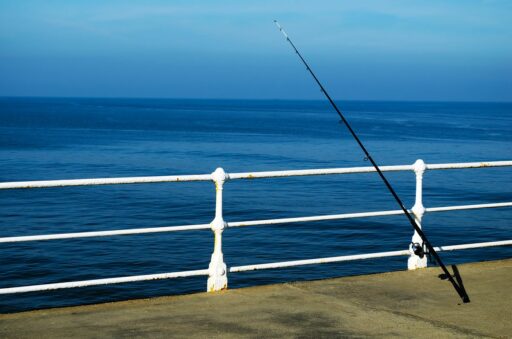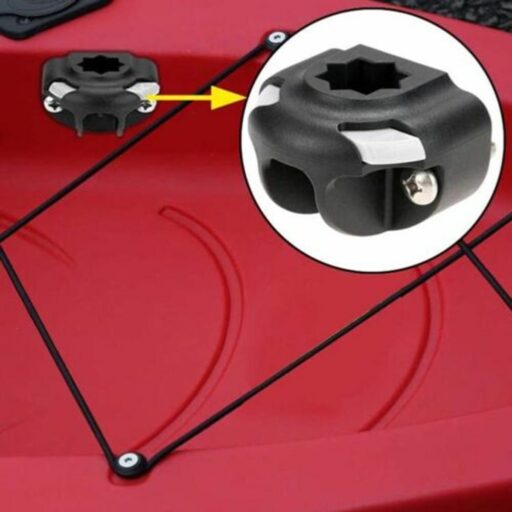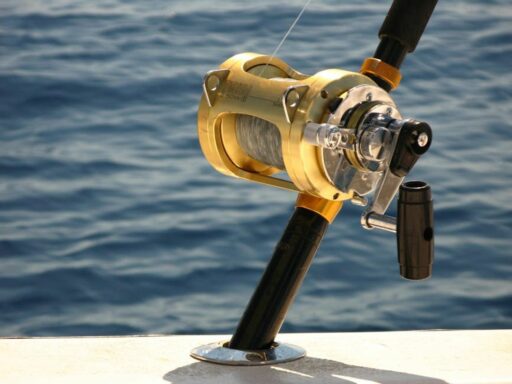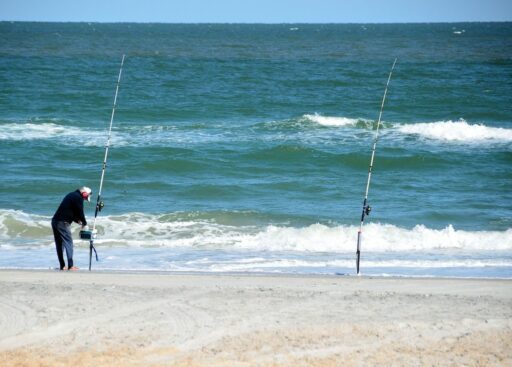Selecting the right gear for saltwater kayak fishing can significantly enhance your angling experience. With the right rod and reel, you can tackle the unique challenges presented by the marine environment and target a variety of species more effectively. This guide provides an in-depth look at the essentials of kayak fishing gear, helping you choose the best equipment for a successful and enjoyable fishing trip.
Key Takeaways
- The ideal kayak for saltwater fishing should be sturdy, balanced, and have room for accessories like rod holders and sonar units.
- Essential rod and reel features include durability to withstand the harsh saltwater environment and the power to handle the targeted fish species.
- When choosing a fishing rod, consider factors such as rod power and action, and ensure they match the specific needs of the saltwater species you aim to catch.
- Reel selection should involve a comparison of spinning and conventional types, taking into account the reel size, gear ratio, and maintenance requirements for longevity.
- Safety is paramount in saltwater kayak fishing, so always wear a personal flotation device (PFD) and be prepared with essential safety gear and knowledge of the risks.
Understanding Kayak Fishing Gear Essentials

Selecting the Right Kayak for Saltwater Fishing
When venturing into saltwater kayak fishing, selecting the right kayak is crucial for both safety and performance. Saltwater kayaks are engineered to handle the rough ocean waters and are typically more robust than their freshwater counterparts. They come with larger bodies that not only provide better balance but also offer ample space for essential accessories like rod holders and sonar units.
Before making a purchase, consider the following points:
- The type of waterways you plan to fish in, as navigating smaller creeks may be challenging with a larger kayak.
- Your storage capabilities and whether the kayak’s size is a practical fit.
- The balance between your budget and the features you require for a successful fishing trip.
It’s essential to strike a balance between the kayak’s features and your specific angling needs to ensure a rewarding saltwater fishing experience.
Remember, while you may be tempted by the allure of a versatile kayak that promises to be suitable for all water conditions, specificity is key. A kayak that excels in saltwater conditions will provide the stability and durability you need for a successful outing.
Essential Rod and Reel Features for Saltwater Kayak Angling
When selecting the ideal rod and reel for saltwater kayak fishing, it’s crucial to balance personal preference with functionality. Durability and corrosion resistance are key features to look for, as saltwater can be harsh on gear. A well-chosen rod and reel can greatly enhance your angling experience, allowing for better control and success in landing your catch.
- Rod Length: Typically, shorter rods (6-8 feet) offer better maneuverability on a kayak.
- Reel Type: Spinning reels are generally easier to use, especially for beginners.
- Material: Look for rods and reels made from materials like graphite or aluminum, which resist corrosion.
- Drag System: A smooth, reliable drag system is essential for handling powerful saltwater fish.
Remember, the right gear should complement your fishing style and the species you target. It’s not about having the most equipment, but the most effective for your needs.
While many anglers obsess over gear, it’s important to consider what kind of angler you are. Do you prefer a minimalist approach with just a few lures and a rod, or do you like to be prepared for every scenario? Your gear choices should reflect your personal fishing philosophy and the practicalities of kayak fishing.
Must-Have Accessories for a Successful Kayak Fishing Trip
To elevate your saltwater kayak fishing experience, certain accessories are indispensable. A well-organized tackle storage system allows for quick access to gear and baits, ensuring you’re ready for any fishing scenario. Whether you prefer a minimalist approach or like to have an array of options at your disposal, the key is to tailor your gear to your personal angling style.
Essential accessories include:
- Rod holders for hands-free fishing and additional rod storage
- Paddle holders to secure your paddles while casting or reeling in
- A variety of lures and pliers for on-the-go adjustments
- A sonar device for locating fish
- An insulated cooler to keep your catch fresh
Remember, the goal is to strike a balance between being well-equipped and maintaining the agility and freedom that kayak fishing provides. Overloading your kayak can hinder maneuverability and reduce your overall enjoyment.
Lastly, consider the importance of a rod holder. It’s often recommended as the first accessory to add to your fishing kayak, enhancing both convenience and efficiency on the water.
Choosing the Perfect Fishing Rod for Kayak Angling

The Best Spinning Rods for Kayak Fishing in 2024
As kayak fishing continues to grow in popularity, the demand for specialized gear has led to the development of spinning rods that cater specifically to the kayak angler’s needs. The right spinning rod can significantly enhance your saltwater fishing experience, offering the perfect balance of sensitivity and strength to battle the unique challenges of the marine environment.
When selecting a spinning rod for kayak fishing, consider the following factors:
- Length: Shorter rods offer better maneuverability in tight spaces, while longer rods provide increased casting distance.
- Power: Choose a rod with enough power to handle the species you’re targeting, but not so heavy that it becomes cumbersome.
- Action: A fast action rod will give you better sensitivity and hook-setting power, which is crucial when fishing from a kayak.
Remember, the goal is to find a rod that feels like an extension of your arm, allowing for precise control and reduced fatigue during long days on the water.
Factors to Consider When Selecting a Fishing Rod
When venturing into the world of saltwater kayak fishing, selecting the right fishing rod is paramount to your success and enjoyment. Consider the rod’s power, weight, and action, as these attributes should align with your fishing location and the species you aim to catch. A rod with the correct power ensures you have the strength to reel in your target, while the weight affects your casting ability and fatigue levels during long sessions. The action of the rod, which refers to how much and where the rod bends, influences your lure’s performance and your ability to detect bites.
It’s not just about whether it catches fish; it’s about optimizing your gear for casting distance and lure performance. A rod that enhances your casting accuracy and sensitivity to strikes can transform your fishing experience.
Here’s a quick guide to help you match rod characteristics with your fishing needs:
- Rod Power: Choose a light to medium power for smaller species and inshore fishing, or go for medium-heavy to heavy power for larger fish and offshore adventures.
- Rod Weight: Lighter rods reduce fatigue but may lack the strength for big fish, whereas heavier rods offer more power at the expense of increased arm strain.
- Rod Action: Fast action rods bend near the tip for better sensitivity and hook setting, while slow action rods bend closer to the handle, providing a smoother cast but less sensitivity.
Matching Rod Power and Action to Your Target Species
Selecting the appropriate rod power and action is a pivotal step in tailoring your gear to the fish you aim to catch. Rod power refers to the rod’s resistance to bending under pressure, while action indicates where the bend will occur along the rod’s length. For instance, a heavy power rod with fast action is ideal for targeting larger species like wahoo, as it provides the necessary backbone to handle their strength and speed.
- Light Power: Best for small fish, offering greater sensitivity.
- Medium Power: Versatile for medium-sized species, balancing sensitivity and strength.
- Heavy Power: Essential for large, powerful fish, providing robust control.
Remember, the right combination of rod power and action can significantly enhance your casting accuracy and the lure’s performance, which are critical factors in successful saltwater kayak fishing.
It’s also important to consider the guide spacing and reel pairing. Proper guide layout aligned with your reel size optimizes casting distance and minimizes issues like wind knots, enhancing your overall fishing experience.
Selecting the Ideal Reel for Saltwater Kayak Fishing

Spinning vs. Conventional Reels: Pros and Cons
When selecting a reel for saltwater kayak fishing, the debate between spinning and conventional reels is a critical one. Spinning reels are generally easier to use and are an excellent choice for beginners or those who prefer a simpler setup. They are particularly effective for lighter baits and lures. On the other hand, conventional reels are better suited for heavy baits and can provide more precision and power for experienced anglers.
-
Spinning Reels:
- User-friendly
- Ideal for light baits and lures
- Better casting distance for lighter tackle
-
Conventional Reels:
- Greater control for heavy baits
- Preferred by experienced anglers
- More power and precision
While there is no clear winner in the spinning vs. conventional reel debate, the choice ultimately depends on the angler’s preference, experience, and the specific fishing situation.
It’s important to consider the type of fishing you’ll be doing and the species you’re targeting when making your selection. Both types of reels have their place in the saltwater kayak fishing arsenal, and understanding their pros and cons will help you make an informed decision.
Reel Size and Gear Ratio: What Works Best for Kayak Anglers
When selecting a reel for saltwater kayak fishing, size and gear ratio are critical factors that can significantly impact your angling success. The ideal reel size for kayak anglers is often compact and lightweight, allowing for easier handling and maneuverability in the confined space of a kayak. Gear ratio, on the other hand, determines how quickly you can retrieve your line, with higher ratios being better for fast-moving species and lower ratios offering more power for larger fish.
- Compact size: Easier to manage on a kayak
- Lightweight: Reduces overall gear weight
- High gear ratio: Ideal for quick retrieval
- Low gear ratio: Provides more torque for big fish
Choosing the right reel size and gear ratio is not just about the technical specifications; it’s about finding a balance that complements your fishing style and the species you target. A well-matched reel enhances your control and efficiency, making every cast count.
Remember, a reel that’s too large can be cumbersome, while one that’s too small may not have the necessary strength. It’s essential to strike the right balance to ensure a productive and enjoyable fishing experience.
Durability and Maintenance: Choosing a Reel That Lasts
When selecting a reel for saltwater kayak fishing, durability should be a top priority. Saltwater environments are harsh on gear, and a reel that can withstand the corrosive nature of the sea is essential. Look for reels with full metal bodies, sealed bearings, and corrosion-resistant materials.
Maintenance is equally important to ensure longevity. A simple maintenance routine can greatly extend the life of your reel. For instance, the Ardent Saltwater Reel Care Maintenance Pack offers a straightforward approach to reel upkeep. It includes three easy steps: clean, protect, and maintain, which can be done quickly after each fishing trip.
Regular maintenance not only preserves your reel’s condition but also improves performance, making every cast and retrieval as smooth as the first.
Here’s a quick checklist for reel maintenance:
- Rinse with fresh water after each use
- Apply lubricant to moving parts
- Check for any signs of wear or damage
- Store in a cool, dry place
By following these steps, you can ensure that your reel remains reliable for many fishing adventures to come.
Maximizing Safety and Enjoyment on the Water

Understanding the Risks of Kayak Fishing in Saltwater
Kayak fishing in saltwater presents unique challenges and risks that must be acknowledged for a safe and enjoyable experience. Navigating the unpredictable nature of the ocean requires preparation and respect for the water.
- Always wear a personal flotation device (PFD) to ensure safety in case of capsizing.
- Be aware of weather conditions and avoid fishing during inclement weather or rough waters.
- Understand the local marine life to avoid dangerous encounters.
- Equip your kayak with the necessary safety gear, including a whistle, knife, and waterproof communication device.
While kayak fishing can be incredibly rewarding, it’s crucial to prioritize safety above all else. Taking the proper precautions can transform it from a potentially hazardous activity into a secure and enjoyable pursuit.
Remember that the sea can be unforgiving, and even experienced anglers can find themselves in challenging situations. By staying vigilant and prepared, you can minimize risks and focus on the thrill of reeling in your next big catch.
Safety Gear and Practices for Kayak Anglers
Ensuring safety while kayak fishing in saltwater is paramount. Always wear a personal flotation device (PFD), regardless of your swimming abilities. PFDs are a critical safety item that can save your life in case of an unexpected capsize. Additionally, it’s essential to dress appropriately for the conditions; this includes wearing layers that can handle getting wet and protect against the sun.
Before heading out, make sure to check the weather and water conditions. Avoid fishing during inclement weather or when the water is rough. It’s also wise to have a well-thought-out plan for your trip, including informing someone onshore of your itinerary.
Here’s a list of basic safety gear every kayak angler should consider:
- Personal flotation device (PFD)
- Waterproof communication device
- First aid kit
- Signaling whistle
- Compass or GPS device
Remember, preparation and the right gear are the keys to a safe and enjoyable kayak fishing experience.
Tips for Maintaining Comfort and Stamina During Long Fishing Sessions
Maintaining comfort and stamina during long kayak fishing sessions is crucial for a successful and enjoyable experience. Dressing appropriately for the weather is key; layering allows you to adjust to changing temperatures throughout the day. Start with a moisture-wicking base layer, add insulation if it’s cold, and always have a waterproof outer layer at hand.
Staying hydrated is essential, so bring plenty of water and avoid alcohol or excessive caffeine. Snacks that provide sustained energy, like nuts, fruits, and granola bars, should be within easy reach. Take regular breaks to stretch and rest, which can help prevent muscle fatigue and stiffness.
Remember, the goal is to enjoy the fishing experience, not to push yourself to exhaustion. Listen to your body and take the time to rest when needed.
Finally, consider the ergonomics of your kayak setup. Ensure that your seat provides proper support and that all gear is arranged to minimize unnecessary movement or strain.
Advanced Tips and Techniques for Kayak Fishing Success

Adapting Your Technique for Saltwater Conditions
When transitioning from freshwater to saltwater kayak fishing, it’s crucial to adapt your angling techniques to the dynamic marine environment. Saltwater species often require different approaches due to their varied behaviors and habitats.
- Understand the target species: Research the habits and preferred habitats of the fish you’re aiming to catch.
- Adjust your tackle: Use corrosion-resistant gear and stronger lines to withstand the harsh saltwater conditions.
- Refine your casting: Practice casting in windy conditions and learn to manage the kayak’s movement in the current.
Adapting your technique is not just about changing your gear, but also about refining your approach to the unique challenges of saltwater environments.
Remember, a comprehensive guide on saltwater fishing tips for beginners can provide valuable insights on bait selection and fishing licenses, which are essential for a successful outing.
The Role of Terminal Tackle in Successful Kayak Fishing
In the realm of kayak fishing, the terminal tackle you choose can make a significant difference in your success rate. High-quality terminal tackle is crucial when targeting species known for their strength and speed, such as wahoo. Using subpar equipment can result in lost fish and squandered opportunities.
Terminal tackle must be organized and easily accessible within your kayak. Proper organization ensures that you can respond quickly to different fishing scenarios, which is often the difference between a good and a bad fishing day.
Here’s a simple list of terminal tackle essentials for kayak anglers:
- Leader material
- Hooks of various sizes
- Swivels and snaps
- Sinkers and weights
- Artificial lures
- Live bait containers
Remember, the right terminal tackle setup is not just about having all the items; it’s about knowing when and how to use them effectively.
Leveraging Technology: Sonar and GPS for Enhanced Fishing
In the realm of kayak fishing, technology plays a pivotal role in enhancing success rates. Sonar devices, for instance, are invaluable for identifying underwater structures and locating baitfish, which are key to finding predatory fish. GPS units, on the other hand, allow anglers to mark productive spots and navigate waters with precision.
Modern sonar units come with a variety of features designed for kayak anglers. Forward-facing sonar, like the Berkley Finisher, optimizes the angler’s ability to keep lures within the strike zone. Similarly, the Berkley PowerSwitch is a versatile lure that works well with sonar, capable of sinking fast and hovering effectively.
By integrating sonar and GPS technology into your kayak fishing arsenal, you can significantly improve your ability to locate and target fish, making each trip more productive and enjoyable.
Understanding how to read and interpret the data from these devices is crucial. SAIL Magazine offers comprehensive guides on using fish finders and selecting the right fishing reel, ensuring that anglers are well-equipped to make the most of their technology on the water.
Conclusion
In conclusion, selecting the right saltwater kayak fishing rod and reel is a personal journey that hinges on your specific angling preferences, the type of fish you’re targeting, and the waters you’ll be navigating. Whether you’re a minimalist angler with a penchant for simplicity or an enthusiast with a taste for the latest gear, the key is to balance functionality with comfort and safety. Remember, the best setup is one that not only suits your fishing style but also ensures a safe and enjoyable experience on the water. So, take the time to research, invest in quality gear that can withstand the challenges of saltwater fishing, and most importantly, enjoy the serenity and thrill that kayak fishing has to offer.
Frequently Asked Questions
What are the most important features to look for in a saltwater kayak fishing rod and reel?
For saltwater kayak fishing, look for a rod and reel that are corrosion-resistant, have a strong drag system, and are of a suitable size and weight for the kayak’s storage and handling capabilities. The rod should have the right power and action for the target species, and the reel should have a high gear ratio for quick retrieves.
Can I use the same gear for both freshwater and saltwater kayak fishing?
While some saltwater rods and reels can be suitable for freshwater fishing, it’s not always the case in reverse due to the corrosive nature of saltwater. It’s essential to use gear that can withstand the harsh saltwater environment. However, the target species and fishing conditions should also guide your choice.
How do I choose the right kayak for saltwater fishing?
Choose a saltwater fishing kayak that is stable, durable, and designed to handle rough waters. It should have ample storage for gear and accessories like rod holders and sonar units. Consider the kayak’s size and weight, as larger kayaks offer more room but can be more challenging to transport and navigate in small creeks.
What safety gear should I have for saltwater kayak fishing?
Safety gear for saltwater kayak fishing includes a personal flotation device (PFD), a whistle or other signaling device, a first aid kit, a paddle leash, and possibly a personal locator beacon (PLB). It’s also wise to check the weather before heading out and to inform someone of your fishing plan.
What is the best way to store tackle and gear on a kayak?
Store tackle and gear in waterproof containers or bags and organize them within easy reach. Many kayaks have built-in storage areas in the front or back, and additional rod holders can be helpful. Keeping your gear organized and secure will help you be ready for any fishing situation.
Are there any particular kayak fishing techniques for saltwater conditions?
Saltwater kayak fishing techniques include adapting to the current and tidal movements, using appropriate lures or bait for the target species, and employing a stealthy approach to avoid spooking fish. It’s also beneficial to leverage technology like sonar and GPS to locate fish more effectively.





